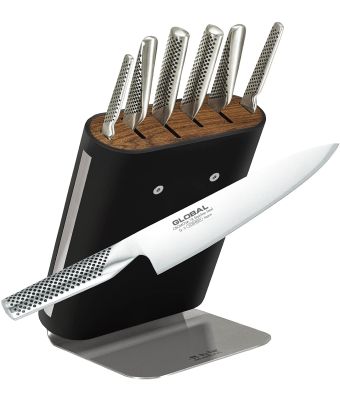Advanced Knife Skills

Once you’ve mastered the basic knife skills such as chopping and slicing and you’re fairly comfortable, it’s time to move onto some of the more advanced techniques out there that you’ll require for more advanced dishes.
They might seem a little daunting at first, but with practice and patience, you should be able to master them in time and achieve much better and more precise results.
In this guide:
- The Intro
- Tourné
- Roll Cut
- Chiffonade
- Batonnet
- Julienning
- Brunoise
Tourné
The tourné cut is used to give you a unique oblong-shaped cut for ingredients such as carrots, potatoes and squash, usually with a curved knife, although any that you’re comfortable with can be used.
Start off by cutting the ends off the ingredient and trimming them down to about two inches.
Then you need to start to form the ingredient into a rough rugby ball shape by removing seven evenly spaced sections around the outside.
Carefully place the ingredient between your thumb and forefinger and peel toward yourself, slowly tapering the knife down toward the end. You’ll do this seven times in each direction for a total of 14 cuts.
Roll Cut
Also known as the oblique cut, this method involves cutting your ingredient so that it has two angled sides and is most often carried out on longer ingredients such as carrots and parsnips.
Not only does it add a bit of visual flair, but the larger surface area can cut down the cooking time too.
Essentially you need to make a cut at a 45-degree angle and simply roll it over about a half turn toward you before repeating the process to cut small triangular shaped pieces.
Chiffonade
A knife skill that you may not have heard of before, chiffonade refers to cutting leafy greens and herbs into long, thin strips (it translates from French to little ribbons) and you’re most likely to use this one when slicing herbs to be used for garnishing.
Start out by stacking up your leaves into a pile and tightly rolling them up into something resembling a cigar shape.
Once you’ve done this, you want to make very thin slices right across the pile, which should give you those nice small ribbons.
Batonnet
The batonnet is the basis not just for proper dicing, but also for other advanced techniques such as julienning and brunoise, but all it essentially means is chopping your ingredients down into small sticks.
Start by cutting off both ends of the ingredient and square it off to form a rectangle. Next, cut the ingredient into slabs of about a quarter inch thickness, before slicing these into strips to create your batons.
Julienning
Julienning also refers to cutting into long thin strips, but is more commonly used with carrots and celery, and leaves you with small matchstick-shaped pieces.
You start out by cutting your ingredient into small segments (about two inches) and cutting off a small part to create a flat base.
Place the ingredient face down on this flat edge and make small, equal slices, which you’ll then stack up on top of each other and slice down again, to create your equally sized matchsticks.
It’s basically the same process as batonneting, although you’ll just chop your pieces once more to make them into the matchstick shapes.
Brunoise is one of the tiniest cuts there is, with ingredients being chopped into neat, small squares.
You’ll start off by julienning the veg, by cutting a flat surface on each side and turning it into a rectangle and cutting lengthwise slices of about an eighth of an inch.
You then need to stack these slices on top of one another and slice into eight inches once again, before finally turning the stick 90 degrees and repeating one last time to create your beautiful tiny squares.
These knife techniques might take a little bit longer to perfect, but they’ll go a long way to giving your food an extra visual flair, so be sure to try them all out and stick at them.

